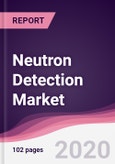These materials are in the form of crystals and paired with a photomultiplier tube, which converts the light flash into an electric signal that indicates the intensity and quantity of the observed radiation. The second major class of detector is the semiconductor-based radiation detectors. The dominant material in this type of detectors is high-purity germanium (HPGe). Neutron detection is finding more applications with growing technological superiority and it is further expected to climb at fast pace with nanotechnology market.
The market for neutron detectors was estimated to be $583.80 m in 2017 and it is expected to grow at a CAGR of 11.25% during forecast period i.e. 2018-2023.
What is Neutron Detection?
Neutron detection can be defined as the detection of neutrons by using an appropriately positioned detector. Detection of atomic and subatomic particles such as neutrons is usually carried out using the signature produced by these particles while they interact with the surroundings.. The key aspects to be taken care of for neutron detection to be effective are parameters such as detector shielding, source-detector distance, and solid angle as well as the graphical analysis tools involved in the set-up of the detection system. Neutral charge makes neutrons to resist direct ionization thus making detection difficult.
What are the major applications for Neutron Detection?
National security is one of the major end user of neutron detection techniques; they employ it for threat detection, arms control and nuclear material assessment. Directionally sensitive neutron detectors can help detect nuclear threats with good accuracy. Studies show that advanced semiconductor detectors loaded with boron are capable of sensing incoming neutron direction vectors.
Helium proportional tubes are used for thermal neutron detection of plutonium. Semiconductor neutron detectors are incorporated in security applications high efficiency, but their size is limited and they are expensive too. Other types of neutron detectors find applications in different sectors. For example, radiation detectors are highly useful in medical imaging, oil well logging and also in the automotive indutry.
Neutron Detection Market
Market Research and Market Trends of Neutron Detection Ecosystem
Nuclear radiation detection has gained prominence across the globe owing to the huge destruction capabilities and security threats. The neutron detection 3He is the dominant material in neutron detection equipment currently. However, new materials are expected to replace the 3He, which is the biggest growth factor in the radiation detection industry. 3He is the byproduct of tritium production in nuclear weapons manufacturing, which is the major source of obtaining 3He. However, due to the end of cold war, the stock of 3He has decreased significantly. The substitutes such as 10B and 6Li loaded glass or coated fibers are thus being used to meet the increasing demand of neutron detection materials,
Neutron detection techniques which include DT-neutron detection and neutron spectrometry are expected to be practiced in future. The growth of the overall market has been slow over the past few decades. There is a compelling need for enhanced neutron detection caused by a technology gap over the years. The research is being carried on to make neutron detection applicable for a wider range of devices and applications.
In many applications it is expected that gas detectors which based on ionization methods will be replaced by solid-state neutron detectors in future due to their size and complexity. For improving the efficiency, cost-effectiveness and eco-friendliness of existing neutron detectors practitioners and researchers have been putting in considerable efforts. There is a need to remove the complications in detection process keeping in consideration the advances from nano science.
Who are the Major Players in Neutron Detection market?
The players profiled in the report include Rhombus Power Inc, Arktis Radiation Detectors Ltd, Silverside Detectors Inc, Leidos, Symetrica Ltd, Mirion Technologies, Atomtex , Canberra Industries , PHOTONIS , POLIMASTER , RAE Systems
What is our report scope?
The report incorporates in-depth assessment of the competitive landscape, product market sizing, product benchmarking, market trends, product developments, financial analysis, strategic analysis and so on to gauge the impact forces and potential opportunities of the market. Apart from this the report also includes a study of major developments in the market such as product launches, agreements, acquisitions, collaborations, mergers and so on to comprehend the prevailing market dynamics at present and its impact during the forecast period 2018-2024.
Key Takeaways from this Report
- Evaluate market potential through analyzing growth rates (CAGR %), Volume (Units) and Value ($M) data given at country level – for product types, end use applications and by different industry verticals.
- Understand the different dynamics influencing the market – key driving factors, challenges and hidden opportunities.
- Get in-depth insights on your competitor performance – market shares, strategies, financial benchmarking, product benchmarking, SWOT and more.
- Analyze the sales and distribution channels across key geographies to improve top-line revenues.
- Understand the industry supply chain with a deep-dive on the value augmentation at each step, in order to optimize value and bring efficiencies in your processes.
- Get a quick outlook on the market entropy – M&A’s, deals, partnerships, product launches of all key players for the past 4 years.
- Evaluate the supply-demand gaps, import-export statistics and regulatory landscape for more than top 20 countries globally for the market.
Table of Contents
Methodology

LOADING...








